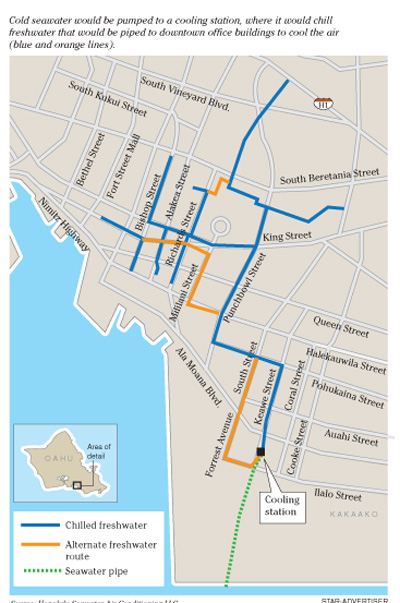Firm gets OK to lay sea pipe off Kakaako for cooling

Honolulu Seawater Air Conditioning LLC has cleared a significant regulatory hurdle in its plan to cool downtown buildings with cold ocean water drawn from the depths off Kakaako.
The company said Wednesday that it received a state conservation district use permit to build and operate the offshore part of its project, clearing the way for construction to begin late this year. Completion is expected in 2013.
The permit, granted by the state Board of Land and Natural Resources, and the Department of Land and Natural Resources, represents a "major step" in a project that will help reduce the state’s dependence on imported oil for energy needs, HSWAC said in a news release.
The system will save "millions of dollars" annually in air-conditioning costs for businesses in downtown Honolulu, said Anders Rydaker, the company’s chief operating officer. Air conditioning is the largest component of a building’s electricity bill, he said.
Rydaker estimated the project will eliminate the need for 178,000 barrels of oil per year. The system is projected to cut electricity consumption for cooling downtown Honolulu by 75 percent, and reduce the use of refrigerants, potable water, sewage and chemicals consumed in air conditioning.
The project will also generate more than $200 million in construction project spending, and create approximately 1,000 construction jobs, he said.
Don't miss out on what's happening!
Stay in touch with breaking news, as it happens, conveniently in your email inbox. It's FREE!
Backed by some $145 million in tax-exempt, special-purpose revenue bonds from the state, the company proposes placing a 63-inch-diameter sea-water intake pipe extending four miles offshore to a depth of 1,600 feet to 1,800 feet, and a 54-inch diameter sea-water return pipe extending 3,500 feet offshore to a depth of 150 feet.
The system would pump about 50.4 million gallons of sea water a day to cool a network of freshwater air-conditioning pipes.
Sea water with a temperature of 45 degrees Fahrenheit would be pumped to a cooling station makai of Ala Moana Boulevard along Keawe Street, where it would undergo a heat exchange with fresh water circulating in a network of pipes to various buildings.
On land the project would involve digging and laying freshwater air-conditioning ducts along a number of streets in downtown Honolulu and extending into historic districts, including Chinatown, Merchant Street and the state Capitol.




